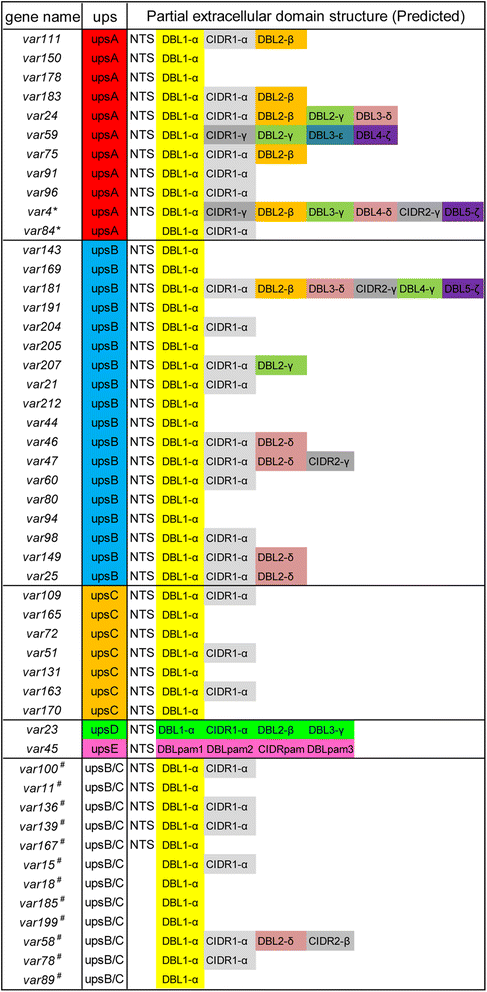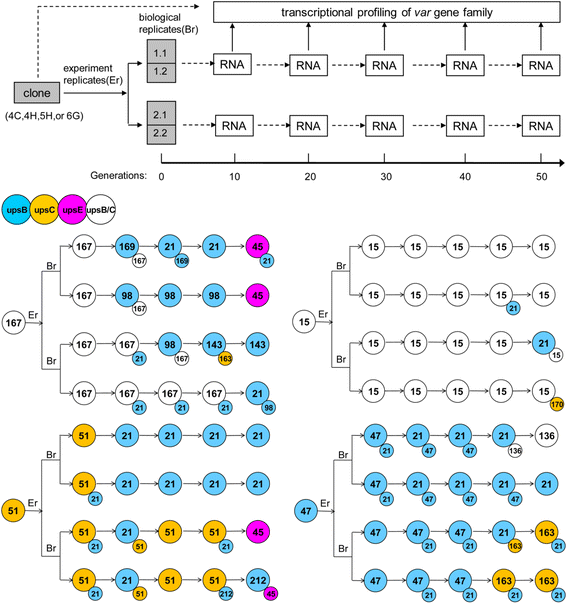Transcription of the var genes from a freshly-obtained field isolate of Plasmodium falciparum shows more variable switching patterns than long laboratory-adapted isolates
- PMID: 25889871
- PMCID: PMC4332720
- DOI: 10.1186/s12936-015-0565-y
Transcription of the var genes from a freshly-obtained field isolate of Plasmodium falciparum shows more variable switching patterns than long laboratory-adapted isolates
Abstract
Background: Antigenic variation in Plasmodium falciparum involves switching among multicopy var gene family and is responsible for immune evasion and the maintenance of chronic infections. Current understanding of var gene expression and switching patterns comes from experiments conducted on long laboratory-adapted strains, with little known about their wild counterparts.
Methods: Genome sequencing was used to obtain 50 var genes from a parasite isolated from the China-Myanmar border. Four clones with different dominant var genes were cultured in vitro in replicates for 50 generations. Transcription of the individual var gene was detected by real-time PCR and then the switching process was analysed.
Results: The expression of multicopy var genes is mutually exclusive in clones of a wild P. falciparum isolate. The activation of distinct primary dominant var genes leads to different and favoured switching patterns in the four clones. The on/off rates of individual var genes are variable and the choice of subsequent dominant var genes are random, which results in the different switching patterns among replicates of each clonal wild P. falciparum isolate with near identical initial transcription profiles.
Conclusions: This study suggests that the switching patterns of var genes are abundant, which consist of both conserved and random parts.
Figures




Similar articles
-
Var Gene promoter activation in clonal Plasmodium falciparum isolates follows a hierarchy and suggests a conserved switching program that is independent of genetic background.J Infect Dis. 2011 Nov 15;204(10):1620-31. doi: 10.1093/infdis/jir594. Epub 2011 Sep 16. J Infect Dis. 2011. PMID: 21926380
-
Variable switching rates of malaria virulence genes are associated with chromosomal position.Mol Microbiol. 2007 Jun;64(6):1486-98. doi: 10.1111/j.1365-2958.2007.05736.x. Mol Microbiol. 2007. PMID: 17555435 Free PMC article.
-
A Unique Virulence Gene Occupies a Principal Position in Immune Evasion by the Malaria Parasite Plasmodium falciparum.PLoS Genet. 2015 May 19;11(5):e1005234. doi: 10.1371/journal.pgen.1005234. eCollection 2015 May. PLoS Genet. 2015. PMID: 25993442 Free PMC article.
-
Mutually exclusive var gene expression in the malaria parasite: multiple layers of regulation.Trends Parasitol. 2008 Oct;24(10):455-61. doi: 10.1016/j.pt.2008.07.005. Epub 2008 Sep 2. Trends Parasitol. 2008. PMID: 18771955 Review.
-
Antigenic variation in Plasmodium falciparum.Annu Rev Microbiol. 2008;62:445-70. doi: 10.1146/annurev.micro.61.080706.093134. Annu Rev Microbiol. 2008. PMID: 18785843 Review.
Cited by
-
In silico guided reconstruction and analysis of ICAM-1-binding var genes from Plasmodium falciparum.Sci Rep. 2018 Feb 19;8(1):3282. doi: 10.1038/s41598-018-21591-8. Sci Rep. 2018. PMID: 29459671 Free PMC article.
-
Mapping immune variation and var gene switching in naive hosts infected with Plasmodium falciparum.Elife. 2021 Mar 2;10:e62800. doi: 10.7554/eLife.62800. Elife. 2021. PMID: 33648633 Free PMC article.
-
Epigenetics of malaria parasite nutrient uptake, but why?Trends Parasitol. 2022 Aug;38(8):618-628. doi: 10.1016/j.pt.2022.05.005. Epub 2022 May 28. Trends Parasitol. 2022. PMID: 35641406 Free PMC article. Review.
References
-
- Su XZ, Heatwole VM, Wertheimer SP, Guinet F, Herrfeldt JA, Peterson DS, Ravetch JA, Wellems TE. The large diverse gene family var encodes proteins involved in cytoadherence and antigenic variation of Plasmodium falciparum-infected erythrocytes. Cell. 1995;82:89–100. doi: 10.1016/0092-8674(95)90055-1. - DOI - PubMed
-
- Baruch DI, Pasloske BL, Singh HB, Bi X, Ma XC, Feldman M, Taraschi TF, Howard RJ. Cloning the P. falciparum gene encoding PfEMP1, a malarial variant antigen and adherence receptor on the surface of parasitized human erythrocytes. Cell. 1995;82:77–87. doi: 10.1016/0092-8674(95)90054-3. - DOI - PubMed
-
- Smith JD, Chitnis CE, Craig AG, Roberts DJ, Hudson-Taylor DE, Peterson DS, Pinches R, Newbold CI, Miller LH. Switches in expression of Plasmodium falciparum var genes correlate with changes in antigenic and cytoadherent phenotypes of infected erythrocytes. Cell. 1995;82:101–10. doi: 10.1016/0092-8674(95)90056-X. - DOI - PMC - PubMed
Publication types
MeSH terms
Substances
Associated data
- Actions
- Actions
- Actions
- Actions
- Actions
- Actions
- Actions
- Actions
- Actions
- Actions
- Actions
- Actions
- Actions
- Actions
- Actions
- Actions
- Actions
- Actions
- Actions
- Actions
- Actions
- Actions
- Actions
- Actions
- Actions
- Actions
- Actions
- Actions
- Actions
- Actions
- Actions
- Actions
- Actions
- Actions
- Actions
- Actions
- Actions
- Actions
- Actions
- Actions
- Actions
- Actions
- Actions
- Actions
- Actions
- Actions
- Actions
- Actions
- Actions
- Actions
LinkOut - more resources
Full Text Sources
Other Literature Sources

